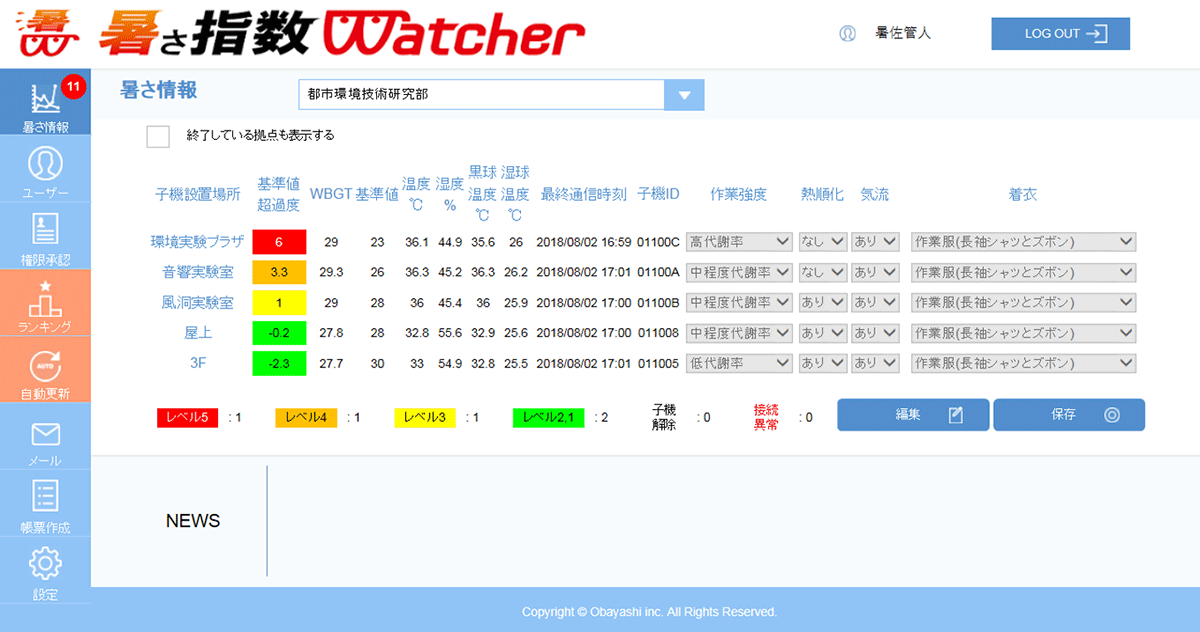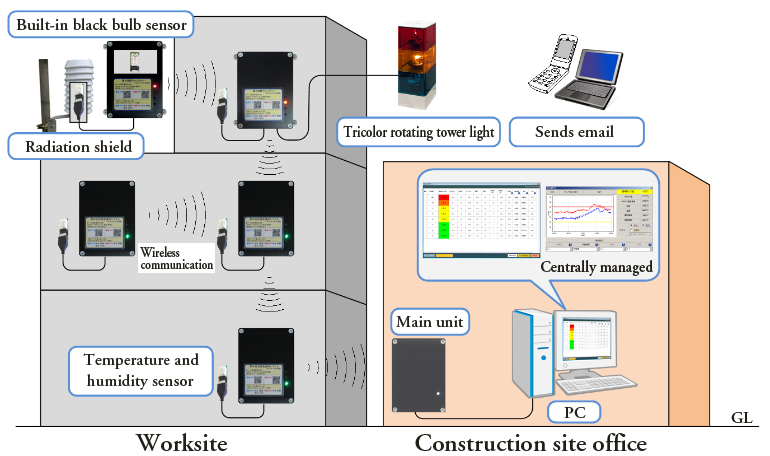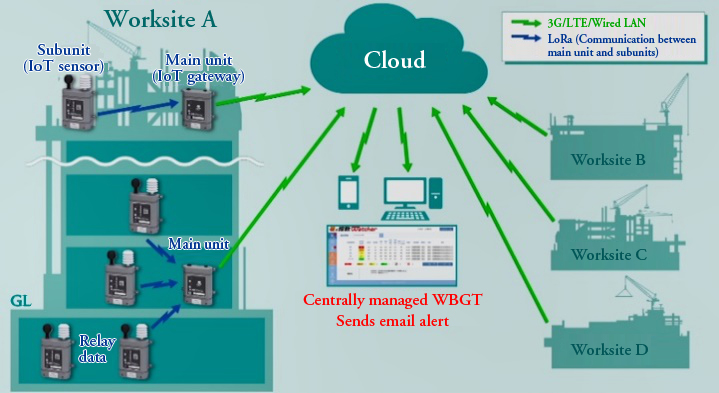- 4 Technology
- Technology Development
Obayashi Develops New, More Convenient and Reliable Atsusa Shisu Watcher
Continuous Measurement and Centralized Management of WBGT Data Offer Low Cost Solution for Preventing Heat Illness
Obayashi Corporation developed the Atsusa Shisu Watcher in 2015 to ensure the safety of workers and employees at construction sites. The WBGT Watcher continuously measures the WBGT (a measure of heat stress) in multiple locations at a worksite and allows for centralized management of the data at the construction site office. In 2018, the system was updated to use the cloud, providing users with more convenience. In addition, the new product costs less and is more reliable because it uses a data transmission method that is best suited for IoT as well as the hardware (main unit and subunits) with a new design.
Coping with heat stress has been an issue for all of society in recent years. Managing heat stress is critical, especially in the construction industry where there are more heat stress-related injuries and illnesses than any other industry. There are many measures in place to prevent heat illness at construction sites. However, for these measures to be appropriate and effective, it is vital to continuously measure thermal conditions of the entire worksite and use the data to take immediate action. Obayashi has been working on improving the work environment at construction sites and developed the Atsusa Shisu Watcher in 2015. The system continuously measures the WBGT, which is used to evaluate thermal conditions, and centrally manages this data. The older version of the WBGT Watcher allowed real-time access to data only on certain PCs that are connected to a network. The subunits had wireless router to transmit data but not very far. Too many obstructions block communication at construction sites. The system was inconvenient, requiring additional subunits to be installed to relay data even in places where it was not necessary to take measurements.
The new Atsusa Shisu Watcher has some of the same functions as the older model. For example, it still automatically sets the WBGT reference values to accommodate work intensity and other conditions. However, it now uses the cloud to share the WBGT that the subunits collect and the levels by which reference values were exceeded. Users can access this data on a tablet or other mobile devices at any time, making it more convenient and useful in managing heat stress. In addition, the new model uses LoRa (LPWA in 920 MHz band), which is suitable for long-distance transmission of data, drastically expanding the communication range. This offers flexibility on where to install subunits and saves on installation cost. Furthermore, using a more durable sensor and simplifying the design with a built-in sensor have decreased the cost of the equipment itself as well as the cost of installation. Users can now start using the system at even lower cost.
The main features of the new Atsusa Shisu Watcher are as follows:
-
Uses the cloud. Anyone can access all of the WBGT data from anywhere, anytime.
The old model was designed for use at construction sites. The subunits at a worksite had a tricolor rotating tower light that gave warnings. The main unit, which collects data from the subunits, were connected to a PC. Construction site managers reviewed the warnings and centrally managed data on a PC in real time and took necessary actions to prevent heat illness. Data such as the WBGT of the work environment was only available on the PC to which the main unit was connected. With the new model, data is sent from the subunits to the main unit and transmitted to the cloud in real time so that data can be accessed by anyone, anytime, anywhere, using a smartphone, tablet, or PC. Not only the site manager but everyone, including workers and foremen, can find out the work environment of the entire construction site. They can then assess each situation and immediately take action to prevent heat illness more effectively, either by modifying work or changing location, for example. In addition, data from multiple buildings and/or construction sites can be consolidated in the cloud system. This allows actions to be taken more efficiently.

Screen showing WBGT by location -
Achieves lower cost with updated design and new data transmission method.
The Atsusa Shisu Watcher creates its own wireless network between the main unit and subunits. The frequency of wireless communication was changed to 920 MHz (the LoRa method), which is suitable for long-distance transmission of data. This drastically expanded the communication range. At a construction site of a high-rise building, for example, the communication range used to be only about four floors above or below. Now it is up to 14 to 18 floors. This reduced the number of subunits needed for relaying data, offering more flexibility on where to install the equipment and savings on installation costs. In addition, the temperature and humidity sensor on the subunit were changed from an electronic model, which is normally used to measure the WBGT, to a more durable capacitive model. Also, the new subunit has a simpler design with a built-in radiation shield to protect the sensors from the sun and rain. This was done to reduce the total cost of the equipment, including maintenance after installation. The total cost is now about one half of that of the old model.

System overview of the old model 
System overview of the new model -
Meets Japanese Industrial Standards (JIS) and is highly reliable.
In March 2017, JIS specified the accuracy of black bulb temperature and humidity sensors (JIS B 7922) to ensure the accuracy of electronic WBGT meters. The new model has a built-in spherical bulb sensor instead of a black bulb sensor to meet the JIS requirements.
Obayashi intends to use the new Atsusa Shisu Watcher whenever possible to make the work environment safer for workers and employees at construction sites. Since the new model was introduced in 2018, the system has been used at more than 300 sites every year until 2020. In 2021, it is expected to be used at more than 350 sites.
Obayashi is committed to addressing the social issue by expanding the use of this system that is less expensive and easy to implement as well as convenient and reliable.
The WBGT is a measure used to prevent heat illness. It focuses on the heat exchange between the human body and surrounding air, and takes into consideration the following factors that have a significant impact on the heat balance of the human body: (1) humidity, (2) thermal condition of the surroundings such as solar and radiant heat, and (3) temperature.
The Atsusa Shisu Watcher is an electronic WBGT meter. It uses a temperature and humidity sensor and a black bulb sensor to calculate the WBGT.
It refers to a wireless communication method that can cover a wide area with little power.
It often uses the sub-GHz band (920 MHz band), so it transmits data slower than other methods that mainly use the 2.45-GHz band, such as Bluetooth and Zigbee. However, it offers long distance coverage and consumes less power.
Therefore, it is suitable for communication with IoT sensors.
The JIS B 7922 Electronic Wet-Bulb Globe Temperature (WBGT) Meter was issued on March 21, 2017, because some commercially available WBGT meters do not have a bulb and cannot measure the bulb globe temperature, which is a component of the WBGT index. JIS B 7922 applies to “electronic WBGT meters with a bulb and humidity sensor.” It specifies the accuracy of the humidity sensor, black bulb temperature sensor, and temperature sensor.
Excerpts from “Heat Environment Evaluation Using the WBGT Index and Establishment of JIS Standard for Electronic WBGT Meters,” National Institute of Occupational Safety and Health, Japan (https://www.jniosh.johas.go.jp/publication/mail_mag/2017/102-column-1.html).
- Management and
Organization- The Articles of Incorporation
- Basic Principles
- Transitioning of Corporate Symbol
- Corporate Officers
- Organization Chart
- Stock Information
- Financial Statements
- Technology
- BIM Timeline
- Awards
- Major Publication
- Group Companies
- Group Companies (in Japan)
- Group Companies (Overseas)